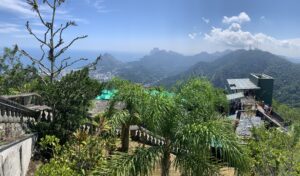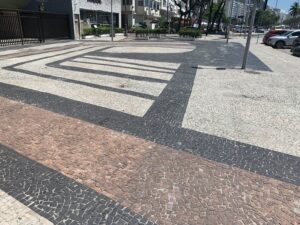 I’ll begin this blog with a joke. In this case, one about Brazil, told to me by a native.
I’ll begin this blog with a joke. In this case, one about Brazil, told to me by a native.
Two guys die and go to purgatory (this is a mostly Catholic country, after all). The attending angel tells the two guys as part of their penance before entering paradise, they will have to eat a bowl of shit each day, served in the manner of any country of their choosing. One chooses Switzerland, the other, Brazil. A long time passes and the eventually, the two guys runs into each other in heaven. The guy who chose Switzerland asks the guy who choose Brazil how he dealt with the bowl of shit each day, noting that the Swiss delivered his allotment each day with the usual Swiss efficiency. The guy from Brazil replies that it wasn’t bad at all since he never had to eat a thing. “The first day, the bowl arrived minus the shit. On the second, the bowl was delivered with its contents, but the delivery guy forgot the spoon. The third day, the delivery guy didn’t show up, and on the fourth, the delivery truck broke down…you get the drift.
viagra natural en herbolarios click here
levitra generico precio this page
The punchline is that in Brazil, nothing works like it’s supposed to, but life goes joyfully on.
I pondered this on the flight down to Rio to meet my partner who was already there on business. I was a sophisticated traveler and didn’t expect London streets to be populated with people who dressed like characters from Downton Abbey any more than I would expect to see old widows dressed in black with bundles of sticks on their backs trundling up hillsides in Italy. The world had changed. But what about Brazil?
With the exception of the mile-long immigration/customs line at the airport, everything seemed to flow fairly well, Rio being pretty much indistinguishable from any big city in the United States. That is, until you actually see it up close.

The city is a sprawling metropolis punctuated by granite peaks that poke up randomly all over the city, like lumps rising from the head of a cartoon character after a series of blows from a comical mallet. A tropical paradise made of extremes.
On the cab ride to the hotel in the Leblon neighborhood, I tried to practice my creaky Spanish, not realizing that most Brazilians stick to their native Portuguese. I told the driver that this was my first time to Rio and that I would like to start a revolution. More practice was necessary.
I got to the hotel which was named the Ritz, checked in and took the elevator with the bellman up to the seventh floor, which stopped at the sixth and refused to go further. The bellman, apparently not surprised at the development, grabbed my suitcase and beckoned for me to follow him up the stairs. When we reached the door to my room, the bellman swiped my key cards several times, but nothing happened. He sighed took the stairs down one flight, where I heard him board the elevator and go down to the lobby to retrieve a new key. A few minutes later, he returned, swiped a key card and we both listened as the bolt withdrew from the door jamb. The bellman pushed the door open with a dramatic flourish and waved me into the room. He spent the next few minutes showing me things I could’ve figured out on my own. I didn’t want to insult him, so I pretended to be astounded as he showed me light switches, drawers and closets, the television and guessing that he was saving the best for last, the air conditioner, which seemed like to merely blow the warm, humid air around the room rather than cool it.
Since I was joining my partner and some of his coworkers for drinks and dinner, I had a little time to kill, so I went out for a walk along the famous Ipanema beach. Had I possessed a better body image, I would’ve slipped on my Speedo and headed for the water, but not in a country that produces sensational models as reliably as it does sugar and coffee. I brought both my black Speedo and some unsexy board shorts, the unflattering, square, bulge-free kind that straight men wear when they don’t want to look too European or gay. If everyone on the beach looked as if they were starring in a Sports Illustrated swimsuit edition, I’d wear the board shorts. If not, Speedos. I sucked in my stomach as I walked and scanned the people sunning themselves on the strip of sand. My eyes landed on saw a woman who, in the words of P.G. Wodehouse, “looked as if she had been poured into her clothes and forgot to say when.” As I continued my walk, I saw more of the same. Men, women, all in swim suits and none of them self-conscious of their bodies. Don’t get me wrong, there was the occasional Adonis here and there, but for the most part, everyone adorning the towels and aluminum folding chairs on the sand didn’t seem to give a fig what they looked like. I knew I was going to like it here and I was definitely going to wear my Speedo.
 The next day, we did what any tourist would do and we visited Corcovado, the mountain on which the world-famous Art Deco statue of Christ The Redeemer stands with outstretched arms. He wasn’t supposed to be so welcoming but was intended to remind people how wicked they were since Brazil had decided to separate church and state. In the end, instead of a huge Christ bearing a Christian cross in one hand and a globe in another, the organizers settled for a less-judgmental and more welcoming statue to be made of reinforced concrete and long-lasting soapstone. They installed lightning rods appropriately shaped like a crown of thrones on his head, along his arms and down his backside, but the designers soon found that just because it was made in the image of the divine, the statue wasn’t guaranteed protection against acts of God. Over the years, lightning strikes have lopped off a finger, damaged the head and singed the eyebrows of the statue, leading to constant repairs. Anyway, Alex and I took the funicular to the top and made our way up the steps to the top. Because it was summer in Rio, it was hot up there and tourists scrambled to stand in Christ’s shadow like repentant sinners. Those who weren’t looking for shade, spread their arms like Christ behind them and had friends snap photos. These were the kind of people who used perspective to make it appear that they held the Great Pyramid of Giza in their hands, were pushing the leaning tower of Pisa upright or had the Eiffel Tower jutting out of their pants like a wrought-iron penis. The view was what everyone had come all that way for, however, and it blew my socks off. It was, to put it bluntly, paradise viewed from on high.
The next day, we did what any tourist would do and we visited Corcovado, the mountain on which the world-famous Art Deco statue of Christ The Redeemer stands with outstretched arms. He wasn’t supposed to be so welcoming but was intended to remind people how wicked they were since Brazil had decided to separate church and state. In the end, instead of a huge Christ bearing a Christian cross in one hand and a globe in another, the organizers settled for a less-judgmental and more welcoming statue to be made of reinforced concrete and long-lasting soapstone. They installed lightning rods appropriately shaped like a crown of thrones on his head, along his arms and down his backside, but the designers soon found that just because it was made in the image of the divine, the statue wasn’t guaranteed protection against acts of God. Over the years, lightning strikes have lopped off a finger, damaged the head and singed the eyebrows of the statue, leading to constant repairs. Anyway, Alex and I took the funicular to the top and made our way up the steps to the top. Because it was summer in Rio, it was hot up there and tourists scrambled to stand in Christ’s shadow like repentant sinners. Those who weren’t looking for shade, spread their arms like Christ behind them and had friends snap photos. These were the kind of people who used perspective to make it appear that they held the Great Pyramid of Giza in their hands, were pushing the leaning tower of Pisa upright or had the Eiffel Tower jutting out of their pants like a wrought-iron penis. The view was what everyone had come all that way for, however, and it blew my socks off. It was, to put it bluntly, paradise viewed from on high.
The next day, we ascended the much-lower Sugarloaf, often confused with Corcovado. You take a cable car and are again treated to astounding views. No Christ there, but lots of flowers clinging to the steep granite. No monkeys there either.
 While they aren’t pervasive in the beach areas, the monkeys are a part of Rio. Not content to eat the plentiful leaves and fruit in the Tijuca National forest that reaches down into the very city, bands of marauding monkeys have invaded Rio. The enterprising simians arrived not to help the handicapped with daily tasks as helper monkeys, but to stage home invasions where they eat food and smash dishes and bowls, leaving the premises looking like Johnny Deep and Kate Moss had spent the night there. Occasionally, the monkeys—who use the spaghetti tangle of wires that supply the people of Rio with telephone, cable and electricity as urban highways—touch the wrong wire and get zapped with high voltage. This, I was told, explains the high-pitched screeches I heard from time to time while walking around the city. Monkey see, monkey don’t.
While they aren’t pervasive in the beach areas, the monkeys are a part of Rio. Not content to eat the plentiful leaves and fruit in the Tijuca National forest that reaches down into the very city, bands of marauding monkeys have invaded Rio. The enterprising simians arrived not to help the handicapped with daily tasks as helper monkeys, but to stage home invasions where they eat food and smash dishes and bowls, leaving the premises looking like Johnny Deep and Kate Moss had spent the night there. Occasionally, the monkeys—who use the spaghetti tangle of wires that supply the people of Rio with telephone, cable and electricity as urban highways—touch the wrong wire and get zapped with high voltage. This, I was told, explains the high-pitched screeches I heard from time to time while walking around the city. Monkey see, monkey don’t.

We stayed with a gay couple who live a block from the Ipanema Beach where a girl once strolled down, leading to the famous song. How she walked down some of the sidewalks was beyond me. The people of Rio take enormous pride in their beautifully patterned sidewalks which are made of square-peg stones the size of a small 3-pack box of condoms. Between the countless haphazard repairs and the tree roots that push up the blocks in search of water, the sidewalks can sometimes be as uneven as a bowl of tapioca pudding. The Girl from Ipanema did not walk down these sidewalks while hammered on Piña Coladas.
Since it was just weeks from Carnival, it was the only subject anyone could talk about. Alex and I watched several YouTube videos of previous years and while most are just plain fantasmagorical, I was struck by the political nature a few of the Carnival processions. I saw multi-story floats centering on government corruption, assassinations and corporate greed. Street dancers dressed up as oil drums with skulls on their exteriors and while others dressed up as greedy businessmen in pursuit of helpless children. I find this not only encouraging, but a refreshing pause from the blatant promotions we see in the Thanksgiving and Rose Bowl parades. There are no cartoon-character balloons alluding to Pillsbury poppin fresh dinner rolls or floats bearing Mariah Carey allegedly lip-synching All I Want for Christmas Is You. The people of Brazil seem to approach Carnival with an attitude that seems to say, “yes, we have problems like anywhere else, but today we party.” Throughout the city, there are “schools” which are community centers where the participants work almost a year in advance preparing their dances and costumes to put on display for just one fantastic night. We went to a samba school one night (the Mangueira) to see some of the costumes and stilt-dancers perform in a crowded auditorium where the beer flowed as easily as did the dancers in their costumes. The Mangueira leans toward the political, but that night, the mood was festive and the music, deafening but infectious. Even I, a suburban boy from the Midwest who dances only when at gunpoint, found myself swaying back and forth to the live bands who played with an all-out abandon. On the night of Carnival, the schools are herded into something representing a colossal Roman hippodrome, where they act out their routines for judges who will crown one school the winner. Brazil has talent! I think I lost a few decibels of hearing that night, but it was worth it.

On another night, our hosts took us out for some local cuisine and we ate grilled chicken hearts and fried sardines with lime. Later, we went to the Bip Bip bar where we listened to a band play Bossa Nova favorites until way past midnight. You could imagine Antonio Carlos Jobim playing in such a place almost half a century ago. The next day, we went down the coast and ate lunch in a very good restaurant practically in a jungle and watched capuchin monkeys running back and forth along the rafters of the restaurant while I kept a watchful eye over my food. Afterwards, we swam in the ocean, which was bath-tub warm, but rough.

On our last day in Rio, Alex and I took the subway to the downtown area. It’s easy to be in a city that often defines itself by its famous beaches and forget that this is Brazil’s second largest city. It doesn’t have sleek-and-chic the sky-scraping high-rise buildings of say, Mexico City, but I was struck how the idea of central air-conditioning seems to have evaded the builders of the office buildings there. Look up and you’ll see hundreds of a/c units perched precariously on facades of the buildings, spraying you with the condensation from stories above. So even when it’s not thunderstorming, you get a light shower whether you like it or not.

We visited the Rio Art Museum (MAR) which featured the art of Brazilian artists and later, made a stop at the MAM (Museum of Modern Art) where my favorite pieces were 30 phonograph spinning turntables with globes perched on the platters and a sculpture of what looked like a contortionist baby jammed into a baby stroller. Unfortunately we couldn’t get into spectacular Museum of Tomorrow designed by Santiago Calatravas because of long lines, which was fine. I got a thrill just walking around the museum and taking photos as keepsakes.

On our final night, we had drinks at a restaurant on the beach and I sighed as I looked over the beachgoers and up to the remarkable backdrop of the Two Brothers granite peaks that tower over the beach, subject of countless postcards and photos. It was breathtaking.
The Brazilians live in a land with almost no earthquakes (at least on the populated side of the country), no hurricanes and only three volcanoes situated hundreds of miles away. There’s political corruption and corporate greed, yes, but that’s just because there are politicians and corporations everywhere. And the disparity between the rich and poor is painfully evident. Not everything works the way it’s supposed to in Brazil, but perhaps that’s a small price to pay. The people of Brazil you see, like to think of themselves as never having to eat a bowlful of shit for the most part. That’s the payoff for living in pretty much a paradise.